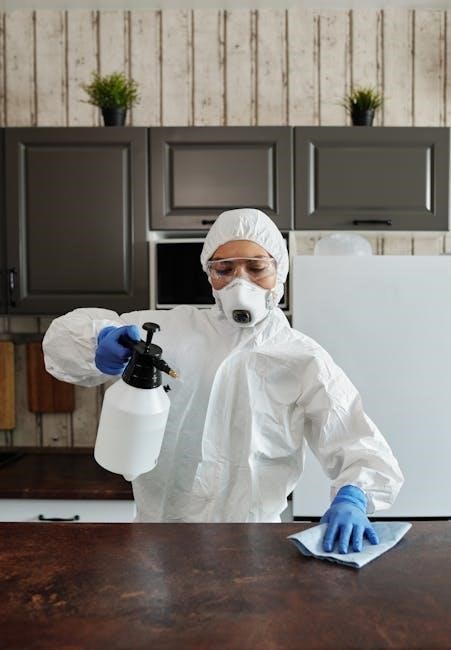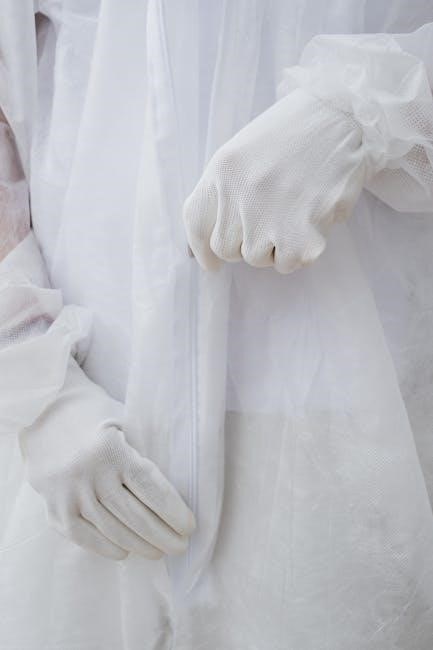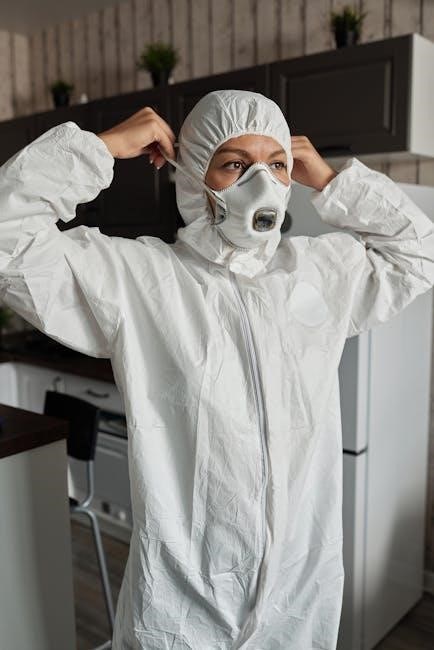Infection Control: Questions and Answers
This section addresses frequently asked questions about infection control, drawing from guidelines and resources provided by organizations like the CDC and WHO. It aims to clarify common concerns from both healthcare professionals and patients.
Infection Prevention and Control (IPC) is a crucial aspect of healthcare, encompassing practices and procedures designed to minimize the transmission of infectious agents. It addresses concerns raised by healthcare professionals and the public. IPC programs are essential in all healthcare settings. These programs aim to protect patients, healthcare workers, and visitors from healthcare-associated infections. Effective IPC involves a multidisciplinary approach. This approach includes strategies such as hand hygiene, environmental cleaning, and vaccination. It also addresses specific pathogen control measures. Guidelines from organizations like the CDC and WHO serve as essential resources for implementing robust IPC practices. Prioritizing IPC is fundamental for maintaining patient safety and quality of care.
Importance of IPC in Healthcare Settings
Infection Prevention and Control (IPC) is paramount within healthcare settings to mitigate the risk of healthcare-associated infections (HAIs). HAIs pose a significant threat to patient safety, increasing morbidity, mortality, and healthcare costs. Effective IPC programs protect vulnerable patients, including those with compromised immune systems or undergoing invasive procedures. Furthermore, IPC safeguards healthcare workers from occupational exposure to infectious agents. By implementing standard precautions and evidence-based practices, healthcare facilities can create a safer environment for everyone. This reduces the burden of HAIs. Investment in IPC is not only ethically responsible but also economically sound, leading to improved patient outcomes and reduced healthcare expenditures. Prioritizing IPC is essential for maintaining quality healthcare services.
Standard Precautions: Minimum Infection Prevention Measures
Standard precautions are the foundational infection control practices that must be consistently applied in all healthcare settings, regardless of the patient’s diagnosis or presumed infection status. These measures aim to minimize the risk of transmission of infectious agents from both recognized and unrecognized sources. Key components include hand hygiene, the use of personal protective equipment (PPE) such as gloves, masks, and gowns, safe injection practices, respiratory hygiene and cough etiquette, and proper handling of sharps and contaminated materials. Implementing standard precautions effectively requires ongoing education, training, and monitoring to ensure compliance among healthcare workers. Adherence to these minimum measures significantly reduces the spread of infections, contributing to a safer healthcare environment for patients and staff alike. Standard precautions should be considered the cornerstone of any robust infection control program.

Hand Hygiene
Hand hygiene is paramount in infection control. Proper techniques, including handwashing with soap and water and using alcohol-based hand rubs (ABHR), are crucial to prevent pathogen transmission in healthcare settings.

Proper Handwashing Techniques
Effective handwashing is a cornerstone of infection prevention. Begin by wetting hands with clean, running water. Apply soap, ensuring coverage of all hand surfaces. Vigorously rub hands together for at least 20 seconds, interlacing fingers and cleaning under fingernails. Rinse thoroughly under running water. Use a clean towel or air dryer to dry hands completely.
When washing, ensure to clean areas often missed, such as thumbs and fingertips. If a towel is used, use it to turn off the faucet to prevent recontamination. Proper handwashing significantly reduces the spread of germs and is a critical practice in all healthcare settings.
Use of Alcohol-Based Hand Rubs (ABHR)
Alcohol-based hand rubs (ABHR) are an effective alternative to handwashing when hands are not visibly soiled. Apply a generous amount of ABHR to the palm of one hand. Rub hands together, ensuring all surfaces are covered, including between fingers and around fingernails. Continue rubbing until hands are dry, typically around 20-30 seconds.
ABHRs are convenient and can be more accessible than soap and water, particularly in busy healthcare settings. They rapidly kill most bacteria and some viruses. Always use ABHR with an alcohol concentration of 60-95% for optimal effectiveness. Ensure proper storage to maintain efficacy.
WHO Multimodal Hand Hygiene Improvement Strategy

The World Health Organization (WHO) promotes a multimodal hand hygiene improvement strategy to enhance adherence in healthcare settings. This strategy encompasses five key elements: system change, training and education, evaluation and feedback, reminders and communication, and institutional safety climate. Implementing these components collaboratively yields the best outcomes.
System change involves ensuring readily available hand hygiene resources, such as ABHR and soap. Training and education equip healthcare workers with the knowledge and skills for proper hand hygiene. Evaluation and feedback provide data on hand hygiene practices, allowing for targeted improvements. Reminders and communication, such as posters, reinforce hand hygiene practices. Fostering a culture of safety encourages hand hygiene as a shared responsibility.

Environmental Cleaning and Disinfection
Maintaining a clean healthcare environment is vital. This section covers regular cleaning protocols and disinfection methods, essential for minimizing pathogen transmission and ensuring patient safety within healthcare facilities.
Regular Cleaning Protocols
Regular cleaning protocols are fundamental in maintaining a safe healthcare environment. These protocols involve the systematic removal of dirt, dust, and organic matter from surfaces to reduce the number of pathogens present. Effective cleaning requires the use of appropriate cleaning agents and equipment, as well as adherence to established schedules.
High-touch surfaces, such as doorknobs, light switches, and bed rails, should be cleaned more frequently. Cleaning staff must be properly trained on correct techniques and the importance of consistent application. Regular monitoring and auditing of cleaning practices can help ensure adherence to protocols and identify areas for improvement, contributing significantly to infection prevention efforts.
Disinfection of Healthcare Environments
Disinfection is a critical process for reducing the number of infectious agents on surfaces after cleaning. It involves using chemical disinfectants to kill or inactivate pathogens that may still be present. The choice of disinfectant should be based on the type of pathogens likely to be encountered and the compatibility with the surface being disinfected.
Proper contact time, concentration, and application methods are essential for effective disinfection. High-touch surfaces and areas with a high risk of contamination should be disinfected more frequently. Healthcare facilities must establish clear protocols for disinfection, including the selection of appropriate disinfectants, training of personnel, and monitoring of effectiveness. Regular review and updates to disinfection practices are necessary to address emerging pathogens and improve overall infection control.

Vaccination and Immunization
Vaccination and immunization are crucial components of infection control, offering protection against vaccine-preventable diseases for both healthcare workers and patients. Strategies should be implemented to maximize immunization rates within healthcare settings.
Importance for Healthcare Workers

Healthcare workers (HCWs) face a heightened risk of exposure to infectious diseases in their daily practice. Vaccination and immunization are paramount for protecting HCWs from acquiring and transmitting infections to vulnerable patients. Maintaining a fully vaccinated workforce helps to ensure patient safety and prevent outbreaks within healthcare facilities, aligning with infection prevention and control guidelines.
Furthermore, immunization programs among HCWs contribute significantly to reducing absenteeism due to illness, ensuring a stable and reliable workforce. Vaccinations protect HCWs from various diseases, enabling them to provide consistent care. Adherence to recommended immunization schedules is an ethical responsibility for all healthcare professionals.
Patient Immunization Strategies
Effective patient immunization strategies are crucial for preventing the spread of infectious diseases within healthcare settings and the broader community. Healthcare providers should routinely assess patients’ immunization status and offer recommended vaccines based on their age, health condition, and risk factors. Implementing reminder systems and standing orders can improve vaccination rates.
Educating patients and their families about the benefits and safety of vaccines is essential for addressing concerns and promoting informed decision-making. Offering vaccinations during routine healthcare visits can increase accessibility and convenience. Collaborative efforts between healthcare facilities and public health agencies can enhance community immunization coverage. Patient immunization strategies are a cornerstone of infection control.

Specific Pathogen Control
This section details specific control measures for different types of pathogens, including airborne and droplet precautions. These tailored strategies are crucial for preventing the transmission of specific infectious agents.
Airborne Precautions
Airborne precautions are essential infection control measures designed to minimize the spread of pathogens transmitted through the air. These precautions are implemented when caring for patients known or suspected to be infected with illnesses such as measles, varicella (chickenpox), or tuberculosis. Key components include placing the patient in a single-patient airborne infection isolation room (AIIR) that is equipped with special ventilation to maintain negative pressure, ensuring that air flows into the room rather than out, preventing contaminated air from escaping.
Healthcare workers entering the AIIR must wear respiratory protection, such as an N95 respirator, which filters out airborne particles. Limiting patient movement outside the room is crucial, and when transport is necessary, the patient should wear a surgical mask. These measures collectively reduce the risk of airborne transmission within healthcare facilities.
Droplet Precautions
Droplet precautions are vital infection control practices used to prevent the transmission of pathogens spread through respiratory droplets produced during coughing, sneezing, talking, or certain medical procedures. These droplets, larger than airborne particles, can travel short distances, typically within three to six feet. Conditions necessitating droplet precautions include influenza, pertussis, and respiratory syncytial virus (RSV) infection.
Implementing droplet precautions involves placing patients in single rooms or cohorting them with others infected with the same pathogen. Healthcare personnel must wear a surgical mask when within close proximity to the patient. Eye protection, such as goggles or a face shield, is also recommended if there is a risk of respiratory secretions splashing. Limiting patient transport is essential; if movement is necessary, the patient should wear a surgical mask to contain droplets at the source.

Infection Control Guidelines and Resources
This section provides a list of key infection control guidelines and resources from organizations like the CDC and WHO. These guidelines offer practical advice for healthcare settings.
CDC Guidelines on Infection Control
The Centers for Disease Control and Prevention (CDC) offers comprehensive guidelines on infection control and clinical safety, aiming to minimize infection risks among healthcare workers, patients, and visitors. These guidelines cover a wide array of topics, including standard precautions, transmission-based precautions, and specific recommendations for various healthcare settings.
The CDC’s resources address hand hygiene practices, environmental cleaning and disinfection protocols, and strategies for preventing healthcare-associated infections; They also provide guidance on vaccination and immunization for healthcare workers and patients. Furthermore, the CDC offers specific recommendations for managing outbreaks and controlling the spread of emerging infectious diseases. These guidelines are updated regularly to reflect the latest scientific evidence and best practices in infection prevention.
WHO Guidelines on Prevention of Hospital-Acquired Infections
The World Health Organization (WHO) provides globally recognized guidelines for the prevention of hospital-acquired infections (HAIs), promoting patient safety and reducing healthcare-associated risks. These guidelines address key areas such as hand hygiene, environmental cleaning, and the appropriate use of personal protective equipment.
The WHO emphasizes the importance of multimodal strategies, like the WHO multimodal hand hygiene improvement strategy, to enhance adherence to infection control practices. Their recommendations are evidence-based and tailored to various healthcare settings, considering resource limitations and cultural contexts. Furthermore, the WHO guidelines cover specific pathogens and infection types, offering practical guidance for prevention and control measures. They promote a comprehensive approach to infection prevention, integrating administrative, environmental, and behavioral interventions to minimize the burden of HAIs worldwide.

Frequently Asked Questions (FAQ)
This section addresses common questions regarding infection control from both healthcare professionals and patients/families. It aims to provide clear, concise answers based on established guidelines and best practices.
Common Questions from Healthcare Professionals
Healthcare professionals frequently inquire about specific infection control protocols, particularly regarding standard precautions and transmission-based precautions. Questions often arise concerning the appropriate use of personal protective equipment (PPE), such as masks, gloves, and gowns, in various clinical settings. Proper hand hygiene techniques, including handwashing and the use of alcohol-based hand rubs, are also common topics of inquiry.
Furthermore, healthcare workers often seek clarification on environmental cleaning and disinfection procedures, especially regarding the selection and application of appropriate disinfectants. Guidance on vaccination and immunization protocols, both for healthcare workers and patients, is also a frequent request. Clarification on the latest CDC and WHO guidelines related to infection control practices and protocols is also often sought after. These questions underscore the commitment to providing safe, effective patient care.
Common Questions from Patients and Families
Patients and their families commonly inquire about the measures healthcare facilities take to prevent infections. They often ask about hand hygiene practices among healthcare staff and the cleanliness of the environment. Questions about the use of antibiotics and strategies to prevent antibiotic-resistant infections are also frequent.
Additionally, patients and families want to know about vaccination policies for both staff and patients, seeking assurance that everyone is protected. Information on specific infection control protocols, such as isolation procedures and the use of personal protective equipment, is also commonly requested. Furthermore, they often seek clarification on how they can actively participate in infection prevention, such as practicing good hand hygiene and reporting any concerns they may have about cleanliness or potential exposures. These inquiries highlight the importance of transparent communication.